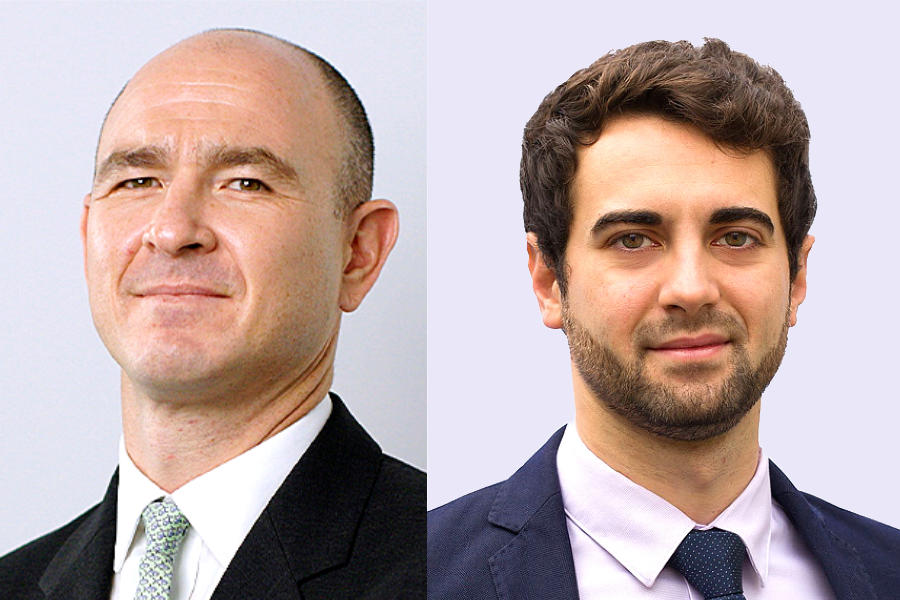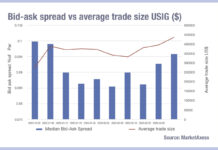
Lee Bartholomew, global head of fixed income and currencies product design, and Davide Masi, fixed income ETD product design at Eurex spoke to The DESK about new credit derivatives
What can Eurex offer in the credit derivatives space?
Davide Masi (DM): Eurex’s credit derivatives range covers both linear and non-linear derivatives, offering Corporate Bond Index futures and Fixed Income ETF Options. Our ambition for this segment is to create a new access point to the credit derivatives market via our listed product suite. Our efforts were driven by extensive market consultations that highlighted the need for a diverse product portfolio to express credit views using ETF and index derivatives, Cash bonds (portfolio trades) and OTC.
Lee Bartholomew (LB): Historically, credit derivatives markets have predominantly traded OTC. Exchange offerings for listed credit products started to develop only after the fixed Income ETF market was established. Through our strategic partnerships with key stakeholders, we aimed to create a product ecosystem that intersects with the OTC layer using ETF options. The European offering is seeing a year-on-year growth trend, with fixed income surpassing equities. In 2021, we leveraged the momentum of the ESG markets post-Covid to launch fixed Income ESG index futures, the first of their kind in the listed space. These products helped us introduce clients and dealers to the idea that credit index futures products could coexist with OTC credit derivatives. Credit futures are increasingly seen as macro products. We have been systematically developing this segment that supplements our current portfolio by introducing products that strengthen the overall fixed income franchise. Clients can use the products for tactical positioning, beta management or expressing directional views.
What client segment are you supporting with these offerings, and how?
DM: Since 2020, our clients expressed the need for listed products that could provide access to the credit derivatives market. Requirements were simple: our clients needed seamless access to these markets and closer exposure to the corporate bonds market, aiming at reducing the basis between the return of existing credit derivatives and their portfolio. Credit index futures were able to satisfy our client’s needs, and additionally, they allow for the implementation of a variety of tactical strategies. We see clients primarily utilising our futures for hedging but also for gaining additional exposure to the European corporate bond markets, using a product closely tied to their benchmarks.
LB: There are three pillars to consider when looking at ways to get exposure to credit via derivatives products. The most evident is the total execution cost, a major consideration for buy-side traders and Portfolio Managers (PMs), as is the execution method supporting them. Then, there’s the product mandate of end users. Long-only asset managers might employ some tactical, macro, and hedge fund-like strategies. Credit index futures can play a role in all these aspects of trading. Finally, credit index futures can attract an even larger group of participants to this market. In fact, CTA-type users could exploit the liquidity of these new futures markets to deploy their short-term trading strategies, adding to the total liquidity of the products and enriching the ecosystem of participants.
The key to segment growth has been the support of our liquidity providers and market makers. It was essential to create a diverse ecosystem at inception, and we were able to achieve this. Having the support of key partners has really helped to build momentum. We are at the start of the journey, and this is something that we are taking a long-term view on.
DM: Looking closely at use cases for these products, the T+0 settlement ensures that credit index futures are instantly available in clients’ portfolios. This feature allows for efficient cash flow management, as clients can immediately re-invest cash coming from coupon payments or fund inflows. We’ve seen clients use the products in traditional strategies such as overlays and bond portfolio equitisation. Futures were also utilised to swiftly manage corporate bond exposures during market downturns. In particular, clients were able to reduce their exposure to credit via our futures at narrow bid-offer spreads instead of unwinding their cash bond portfolios, avoiding paying prohibitive liquidity premiums in times of distressed markets.
Currently, our credit derivatives product suite covers:
- Bloomberg MSCI Euro Corporate SRI (Euro Investment Grade) Index Futures
- Bloomberg Liquidity Screened Euro High Yield Index Futures
- USD Investment Grade and High Yield iShares UCITS ETF Options
- EUR Investment Grade and High Yield iShares UCITS ETF Options
- $ Emerging Market Sovereign and 20+ Year USD Treasury iShares UCITS ETF Options
What is Eurex’s vision for the credit derivatives markets, and how are you positioning yourself?
LB: We continue building a systematic product strategy and are playing the long game. As we establish ourselves in this product space, we can expand into other regions where we have a strong franchise. Our ambition is to be the incumbent liquidity pool for credit derivatives, and we are committed to executing this.
We’ve demonstrated our ability to launch a successful futures product by working hand in hand with our partners, stakeholders, liquidity providers and end clients. It is important that we were able to build a diverse liquidity pool and ecosystem at inception. We cooperate closely with key stakeholders, differentiating our approach from others. Beyond that, what can we do? We can fully leverage the connectivity we offer in distribution and risk-based analytics areas. There will be more synergies that will materialise before year-end. It is critical that we build around our strength in derivatives with services that support and meet client needs.
Why are sell-side organisations supporting your efforts?
LB: The sell side has been supportive of the product as we have demonstrated that both listed and OTC can coexist. This has led to a mindset shift and listed is seen as part of the overall toolkit. Additionally, it is creating new liquidity pools. That benefits the whole market.
DM: The growing interest from asset managers in these products has highlighted the importance of credit index futures on the sell-side organisations’ agendas. Buy-side clients find these products attractive thanks to their accessibility via Eurex’s well-known infrastructure. They also view credit index futures as an efficient tool to attain exposure, be it long or short, to the Euro corporate bond market.
For sell-side organisations, credit index futures supplement their fixed income ETF and corporate bonds book, integrating seamlessly within the credit ecosystem. Dealers who provide liquidity in fixed income ETFs and portfolio trades can re-use the same technology to provide liquidity in credit index futures as they tap into the same underlying market. We’ve seen, in particular, dealers being able to leverage the whole credit cash and derivatives market ecosystem to ensure that the best prices were offered in credit index futures.
How do your products compare to OTC products, such as CDS indices?
DM: Our credit index futures product suite is designed to provide investors a new entry point to the credit derivatives market. Our vision for these products is to grow in parallel to traditional credit derivatives, enriching this ecosystem and providing our clients with new avenues to manage their portfolios. There are a few key differences between credit index futures are CDS indices. The most important is the fact that our products are futures on Total Return Indices. Hence, entering a future position will give exposure to both interest rate and credit spread risk. With CDS indices, you have exposure only to the credit spread risk.
The second important difference is in the methodology of the underlying indices. Credit index futures are based on broad corporate bond indices. In the Euro Investment Grade space, these include over 3,000 bonds and 700+ issuers. The Issuers’ weight in the index is based on the bonds’ amount outstanding. Credit Default Swap indices have a narrower composition, and issuers are equally weighted in the index composition.
LB: Several factors can affect end-user’s decision on which credit derivative product to use. Some clients may look solely for the pure credit exposure, stripped out of the interest rate component. However, we foresee much more interoperability between these markets. OTC credit is on this electronification trajectory. Considering the heterogeneous nature of bonds in general, I don’t foresee the same level of commoditisation as in equities, but you expect an acceleration of the futures products complementing OTC.
How are you developing the ETF ecosystem, and how are these developments important to express credit risk?
LB: Our key challenge is ensuring an increase in trading frequency over time, establishing a critical mass with end users. One aspect that we would like to see is an increase in fast money utilising the products within Europe. We are exhibiting liquidity in the European underlying to foster volume and frequency. We have seen across fixed income that the liquidity is there in the products when clients want to put risk on. Up to c.1bn equivalent of the underlying has traded in some instances. As the tape develops and clients become more comfortable using the products, I’d expect to see a material pick up in the trading frequency.
What’s your current market outlook?
LB: In credit, there’s a combination of underpricing where rates will go versus a lag in the data. As data has been coming in stronger, there has been a resurgence in yield. There could be challenges with US regional banks, while European banks are in a different position from a capital perspective.
Are we likely to see further credit challenges ahead?
LB: Yes, even though we’ve not necessarily seen that materialise yet. I think rates will stay higher. We will need to see the economic pinch and find out what that means for future corporate earnings and the accessibility of credit by public and private institutions. At Eurex, we will continue to build our credit derivatives product suite, enabling clients to express views in this segment such that, when opportunities do arise, they can take advantage of them. To reiterate, our focus is on building products that support the broader, structural themes, which we are well positioned to do.
©Markets Media Europe 2023

























